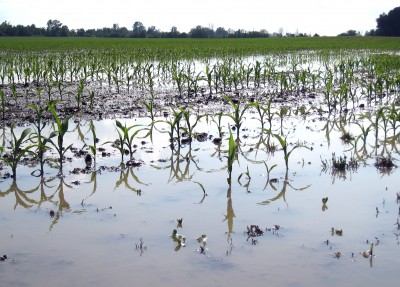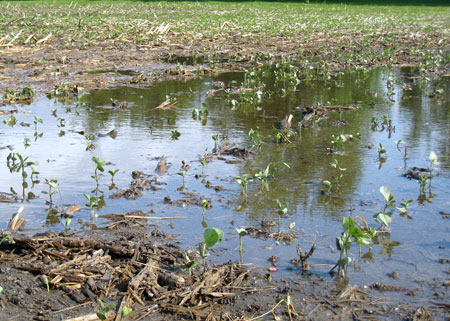By Marilyn Thelen
 Corn 26 hours after rain. Photo credit: Marilyn Thelen, MSU Extension |
Heavy rains, strong winds, hail and even tornadoes leave their mark on fields across the Midwest every year. If your farm is in the path of one of these storms, there is not much you can do, except seek shelter and assess the damage when the coast is clear. As the sun starts to peak through the clouds, a drive around the area is warranted to see what damage occurred. By the time the field is dry enough to walk across, hopefully in three to 10 days, an accurate assessment of plant survival can be made.
Plants in flooded fields can survive, but the odds are against them. If water drains away quickly, the plants are not covered by mud or crop residue and the soil moisture returns to normal within a day or so, the plants may survive. Well-drained soils increase the odds, but there are fields where at least one of these factors will put plants at risk.
Fully submerged plants are at greatest risk of "drowning." Respiration of both corn and soybean plants that are underwater will use up the minimal oxygen that is available and the plants will die. This occurs faster with higher temperatures. In fact, corn prior to the sixth leaf stage may die after just 24 hours if temperatures are over 77 F. Soybeans can survive two to four days under water. Cooler temperatures and cloud cover will improve survival.
 Soybeans 26 hours after rain. Photo credit: Marilyn Thelen, MSU Extension |
When waters go down, they often leave plants covered in soil or crop residue. This can decrease the plants ability to conduct photosynthesis, further putting the plants’ survival at risk. Oddly enough, the best thing for a “dirty” plant would be another rain to wash the leaves. Taking time to remove crop residue drifts from plants will increase plant survival.
Poorly drained areas of the field may stay too wet for too long. If this occurs, plants may suffer from root rot, resulting in stunted growth, reduced stand and will possibly make plants more susceptible to disease.
Once the water has drained away and three to 10 days have passed, it is time to see what plants have survived and get an accurate stand count. There are two methods that can be used: counting viable plants in a row equal to 1/1,000 of an acre, or counting viable plants within in a sampling area, i.e., the hula-hoop method.
To begin, select the method that best fits the production system being evaluated. As a general rule, the hula-hoop method works well for drilled soybeans, and the length method works well for rows. Tables 1 and 2 are from the Michigan State University Extension article “Assessing soybean emergence” by Mike Staton.
Table 1. Length of row required to equal 1/1,000 of an acre
|
Row width (in inches) |
Length of a single row to equal 1/1,000 of an acre |
|
15 |
34 feet and 10 inches |
|
20 |
26 feet and 2 inches |
|
22 |
23 feet and 8 inches |
|
28 |
18 feet and 8 inches |
|
30 |
17 feet and 5 inches |
To use the information in Table 1 to estimate the number of soybean plants per acre in 30-inch rows, count the number of plants in 17 feet, 5 inches of row at 10 random locations in the field. Simply multiply the average count for the 10 locations by 1,000 to get plants per acre. For example, if the average count in the sampled rows was 108, the population would be 108,000 emerged plants per acre.
Table 2. Converting hula hoop plant counts to plants per acre
|
Inside diameter of hula hoop (inches) |
Conversion factor (multiply the number of plants within the hoop by the appropriate factor to calculate plants per acre) |
|
36 |
6,616 |
|
33 |
7,334 |
|
30 |
8,874 |
|
27 |
10,956 |
|
24 |
13,865 |
To use the hula-hoop method, toss the hoop in 10 random locations in the field and record the number of emerged plants within the hoop at each location. Calculate the average and multiply it by the appropriate conversion factor for the diameter of the hoop you are using. For example, if the diameter of the hoop is 30 inches and the average number of emerged plants is 16, the population is 143,984 emerged plants per acre (16 x 8,874). If the diameter of your hula hoop is not listed in Table 2, you can calculate the conversion factor with the following equation:
Conversion factor = 43,560 ÷ [3.14 x (the inside hoop diameter in inches ÷ 2)2 ÷144]
Plants can survive a flood! Getting the water drained off as soon as possible and removing any crop debris will help. By the time you can safely pull a planter into the field, you might be surprised at the number of plants that are alive and well. Assess the stand before you decide to replant.
Resources:
- Corn survival in flooded or saturated fields, ISU Agronomy Extension
- Extension responds: Flood, University of Wisconsin Extension
- Effects of flooding or ponding on young corn, Purdue University
This article is one of a three-part series on field assessment of corn and soybeans when they have been impacted by flooding, hail and wind.





